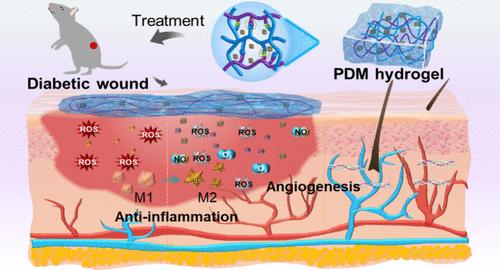A Sustained Oxygen- and Nitric Oxide-Producing Hydrogel Accelerates Methicillin-Resistant Staphylococcus aureus-Infected Diabetic Wound Healing under Hypoxia
IF 7
2区 材料科学
Q2 CHEMISTRY, PHYSICAL
引用次数: 0
Abstract
Chronic inflammation and hypoxia in the diabetic hyperglycemic microenvironment can lead to persistent vascular impairment, hindering tissue regeneration and exacerbating adverse outcomes. We propose a multifunctional regeneration strategy capable of simultaneously releasing oxygen (O2) and nitric oxide (NO) to enhance immune regulation and angiogenesis, significantly accelerating wound healing. Here, a dual-dynamic-network hydrogel was designed for in situ depletion of excess reactive oxygen species (ROS) and immunomodulation to accelerate the remodeling of MRSA-infected diabetic wounds. The hydrogel was constructed using Schiff base and phenylborate ester bonds, with l-arginine-modified manganese dioxide (ACM) nanoparticles integrated into its framework. This hydrogel could respond to ROS in the diabetic microenvironment and subsequently generate oxygen and nitric oxide. Studies have shown that PDM hydrogel exhibited good biocompatibility, promoted cell migration, and facilitated endothelial cell tubular formation. Mechanistically, in vitro and in vivo analyses revealed that PDM could relieve excessive ROS levels, restore mitochondrial membrane potential, down-regulate pro-inflammatory marker CD86, up-regulate anti-inflammatory marker CD206, and promote macrophage polarization toward a reparative phenotype. In MRSA-infected full-thickness skin wounds, the PDM hydrogel alleviated hypoxia by decomposing endogenous H2O2 into O2 (thereby reducing HIF-1α expression), modulated inflammatory responses (downregulating TNF-α and upregulating CD206), enhanced the expression of angiogenic factors VEGF and CD31, and increased collagen I deposition. These findings suggest that the multifunctional PDM hydrogel holds clinical potential for reshaping the damaged tissue microenvironment and offers an effective therapeutic strategy for chronic skin wound regeneration.

一种持续产氧和一氧化氮的水凝胶加速耐甲氧西林金黄色葡萄球菌感染的糖尿病伤口在缺氧下愈合
糖尿病高血糖微环境中的慢性炎症和缺氧可导致持续性血管损伤,阻碍组织再生并加剧不良后果。我们提出了一种多功能再生策略,能够同时释放氧气(O2)和一氧化氮(NO),以增强免疫调节和血管生成,显著加速伤口愈合。本研究设计了一种双动态网络水凝胶,用于原位消耗过量活性氧(ROS)和免疫调节,以加速mrsa感染的糖尿病伤口的重塑。该水凝胶采用希夫碱和苯硼酸酯键构建,并将l-精氨酸修饰的二氧化锰(ACM)纳米颗粒整合到其框架中。该水凝胶能够对糖尿病微环境中的活性氧作出反应,随后产生氧气和一氧化氮。研究表明PDM水凝胶具有良好的生物相容性,促进细胞迁移,促进内皮细胞小管形成。机制上,体外和体内分析表明,PDM可以缓解过多的ROS水平,恢复线粒体膜电位,下调促炎标志物CD86,上调抗炎标志物CD206,促进巨噬细胞向修复表型极化。在mrsa感染的全层皮肤创面中,PDM水凝胶通过将内源性H2O2分解为O2(从而降低HIF-1α的表达)缓解缺氧,调节炎症反应(下调TNF-α,上调CD206),增强血管生成因子VEGF和CD31的表达,增加I型胶原沉积。这些发现表明,多功能PDM水凝胶具有重塑受损组织微环境的临床潜力,并为慢性皮肤伤口再生提供了有效的治疗策略。
本文章由计算机程序翻译,如有差异,请以英文原文为准。
求助全文
约1分钟内获得全文
求助全文
来源期刊

Chemistry of Materials
工程技术-材料科学:综合
CiteScore
14.10
自引率
5.80%
发文量
929
审稿时长
1.5 months
期刊介绍:
The journal Chemistry of Materials focuses on publishing original research at the intersection of materials science and chemistry. The studies published in the journal involve chemistry as a prominent component and explore topics such as the design, synthesis, characterization, processing, understanding, and application of functional or potentially functional materials. The journal covers various areas of interest, including inorganic and organic solid-state chemistry, nanomaterials, biomaterials, thin films and polymers, and composite/hybrid materials. The journal particularly seeks papers that highlight the creation or development of innovative materials with novel optical, electrical, magnetic, catalytic, or mechanical properties. It is essential that manuscripts on these topics have a primary focus on the chemistry of materials and represent a significant advancement compared to prior research. Before external reviews are sought, submitted manuscripts undergo a review process by a minimum of two editors to ensure their appropriateness for the journal and the presence of sufficient evidence of a significant advance that will be of broad interest to the materials chemistry community.
 求助内容:
求助内容: 应助结果提醒方式:
应助结果提醒方式:


